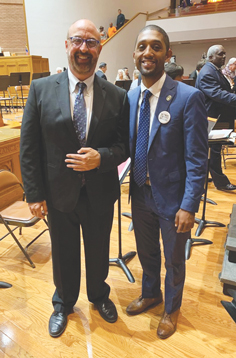By Jane Marvine, Member of Local 40-543 (Baltimore, MD)
I began my tenure at the Baltimore Symphony Orchestra (BSO) serving on the Players’ Committee during a time of great change. The year was 1981. We had plans to build the Joseph Meyerhoff Symphony Hall and we were locked out by management for 12 weeks. The resulting settlement created a network of supporters called Friends of the BSO and also saw the birth of our 52-week contract. Forty years later, after negotiating numerous contracts, some with incredible gains and some with devastating concessions, I found myself locking arms with my colleagues and supporters once again to save our great orchestra that has taken 103 years to build.
After being locked out for 14 weeks during the 2019 summer, the mid-September contract settlement preserved annual salary thanks to a group of supporters who stepped forward. However, the remaining questions on weeks and size of orchestra were left unresolved. The settlement included the establishment of a standing board committee, the Vision Committee, which is comprised of board, staff, musicians, and community members. The Vision Committee has examined every aspect of the BSO and, to my delight, promises of true collaboration were immediately apparent in the dialog and inclusion in the decision-making taking place.
After bridge funding from the John C. Merrill Act, which was passed by the Maryland General Assembly last year, was withheld, the Work Group, as mandated in the legislation, started meeting. Invited speakers shared concerns and gave advice. Michael Kaiser was invited to speak and was subsequently hired to articulate a vision and draft a plan. The result was embraced by the Vision Committee, approved by the BSO board, and inspired donors to create a transformational fund. Within three months, nearly $10 million has been raised to cover shortfalls for the current year and forestall the use of next season’s ticket money.
On February 25, the Work Group submitted its report to the Maryland General Assembly, which included its support for the Kaiser plan. In the report are a series of recommendations to improve community engagement, education, and the patron experience; board development; and the use of technology. It recommends five additional years of bridge funding from the state of Maryland to help the BSO put many of the proposals into practice.
One of the most important aspects of the plan is the recommendation that the orchestra maintain the 52-week structure. Kaiser advocates that success is dependent on putting the art first, and that generating enthusiasm for the artistic product of the organization is the number-one factor in driving contributed and earned income. The musicians have supported the plan enthusiastically since it articulates that the art we make is the key to success and therefore preserves what we have built so far. The plan has rallied a new spirit and understanding from the staff, board, and donor community regarding the importance of this essential message. Alignment of all stakeholders is a beautiful and powerful source of strength.
Testimony was given to the state legislature by Ed Kasemeyer, retired state senator and former chair of the Budget and Taxation Committee and Work Group chair; Michael Kaiser, turnaround consultant; Peter Kjome, BSO president and CEO; and myself on March 12. The testimony included the update that nearly $10 million has been raised for the transformational fund. Concurrently, it was announced that $1.6 million of grant money from the Merrill Act was restored for the fiscal year which begins in July 2020.
On March 17, 2020 the bill providing additional funding to support Kaiser’s plan was passed by the Maryland General Assembly and awaits Governor Hogan’s signature to become law. This funding will allow the BSO to maintain its structure, increase investment in needed areas for income growth, and pave the way for restoration of the orchestra complement. The BSO will be establishing new ways to connect with communities and partner with arts organizations across the state. Musicians will be leaders in making that happen.
Amid all of this positive news and hard work, COVID-19 has hit our country and performing arts organizations with a sledgehammer. Just as we are emerging from a devasting—nearly fatal—episode, this is especially challenging for the Baltimore Symphony Orchestra. The effects of this global pandemic on the BSO remain to be seen. Personally, I am hopeful that the new level of inclusion and transparency across the organization for all stake holders, including our donors and community members, will continue to inspire us all and create a constructive path forward. We are working together in an unprecedented fashion and this gives me hope for a bright future in spite of the challenges we face.


